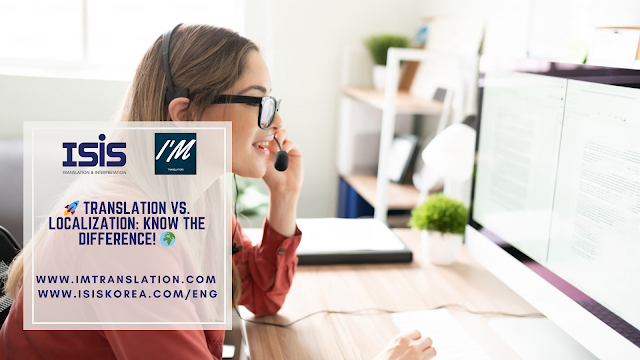Important distinctions and overlaps between translation and localization
Important distinctions and overlaps between translation and localization
Definition of Translation: The process
of translating a text from one language to another without changing its
original meaning is called translation. It mostly concentrates on the language
component of the information.
Key Characteristics:
ü Word-for-Word:
Translation often involves a more literal conversion of words and phrases.
ü Language-Focused:
The main goal is to convey the original message accurately.
ü Contextual
Sensitivity: Translation must account for linguistic differences but doesn’t
always address cultural context in detail.
Real-World Example: Imagine a
company releasing a user manual for a new product. The translation would
involve converting the manual from English to French, ensuring that technical
terms and instructions are accurately represented in French. For instance,
"right-click" would be translated as "clic droit."
Definition of localization: Localization
is the process of modifying content to conform to the social, cultural, and
regional conventions of the intended audience. It goes beyond translation. It
guarantees that the information seems suitable and natural in the altered
setting.
Key Characteristics:
ü Cultural
Adaptation: Localization takes into account quirks, traditions, and regional
tastes.
ü Measurements,
date formats, currencies, and other region-specific information are adjusted
through regional customization.
ü User
experience: Makes sure the information is in line with the attitudes and
actions of the intended audience.
Real-World Example: Consider a
video game developed in the US and localized for the Japanese market.
Localization might involve:
ü Cultural
References: Changing American cultural references to ones familiar to Japanese
players.
ü Visuals:
Adapting character costumes and designs to align with Japanese aesthetic
preferences.
ü Dialogues:
Adjusting humor and dialogue to resonate with Japanese audiences while ensuring
that jokes and puns make sense in the new context.
Intersection of Translation and
Localization
While translation and localization have distinct focuses,
they often overlap, especially in global projects. Effective localization
usually starts with accurate translation but then incorporates additional
elements to ensure cultural appropriateness.
Example of Intersection:
E-commerce Website:
• Translation: Product descriptions, customer reviews, and
terms of service are translated from English to Spanish.
• Localization:
ü Cultural
Preferences: Product names and descriptions are adapted to reflect local
terminology and preferences.
ü Currency and
Measurements: Prices are converted to Euros, and measurements are changed to
the metric system.
ü Visual
Elements: Images and graphics are adjusted to appeal to Spanish-speaking
audiences.
Summary
Translation is the process of translating a text from one
language to another without changing its meaning.
Translation is only one aspect of localization; another is modifying the
material to suit the target audience's cultural and geographic environment.
Real-World Integration: In order to
make sure that the material is not only understood but also well-received and
engaging in the new market, successful localization goes beyond exact
translation to include cultural adaptation.
Businesses may more effectively adapt their content to suit
the demands of various audiences throughout the world by knowing the
differences and points where localization and translation overlap.
Need a translation? I’M Translation and ISIS Korea provides professional translation and interpretation services.
If your company or
institution requires expert translation or interpretation services, consider
working with ISIS Korea. We provide a
variety of services adapted to the unique requirements of your industry,
providing clear and accurate communication between languages. Contact us via www.isiskorea.com/eng




Comments
Post a Comment